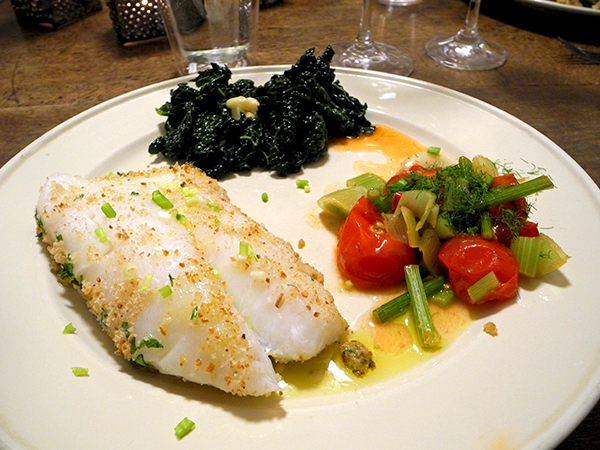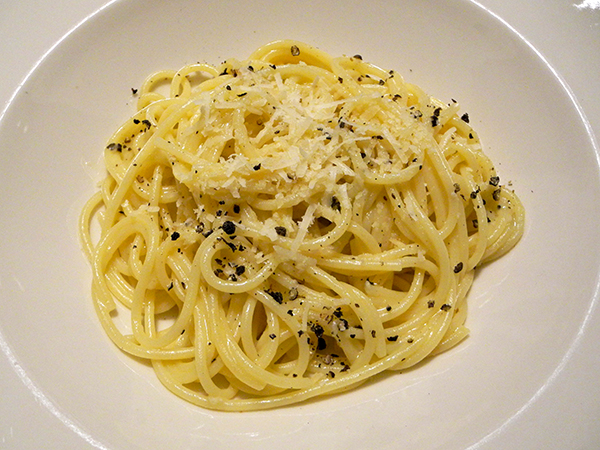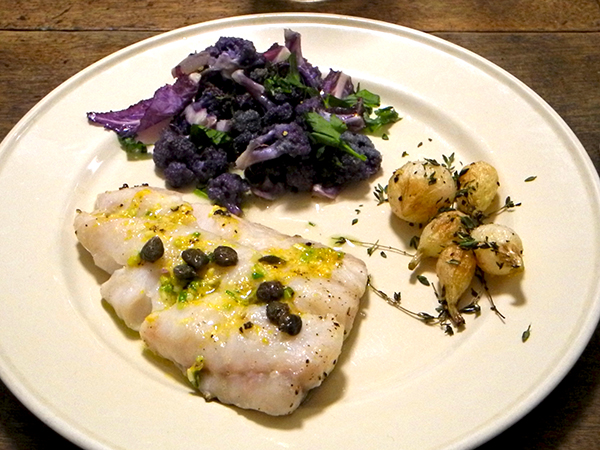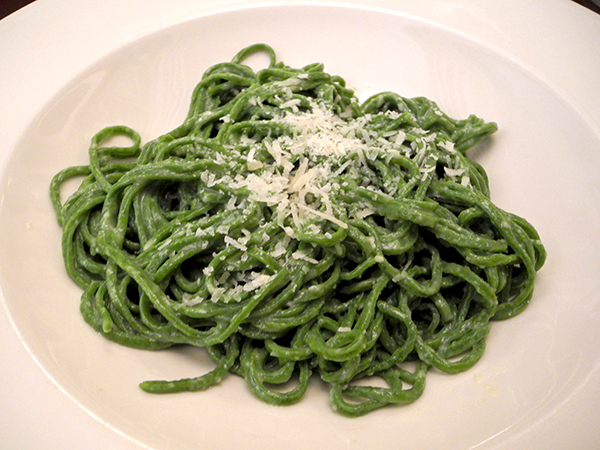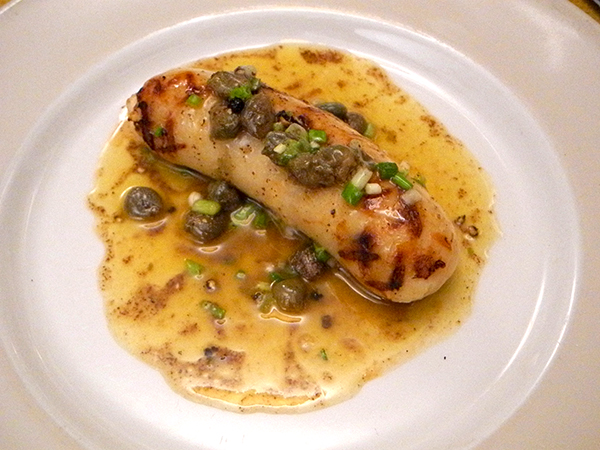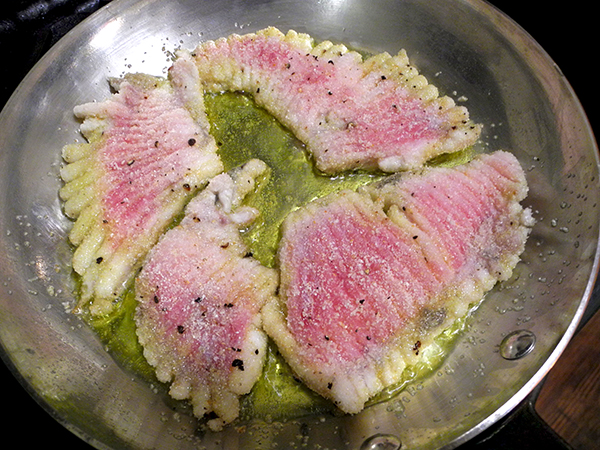
very happy with this meal
Holidays and weekends shouldn’t be the only occasions for special meals, and besides, what’s ‘special’ when you’re trying to do your best all the time? Still, I have to admit that this was pretty special, and while I served it on an ‘ordinary’ Monday, that wasn’t my original intention. It was supposed to be Sunday dinner. The fact is, earlier last week I had gone back and forth in my head about whether to marinate these venison chops 24 hours ahead of time, and in the end decided to play them quite straight (no marinade). So I missed my cue for removing them from the refrigerator, and did not realize it until almost 10:30 Sunday night.
The new plan for that night was to put together a dish of rich pasta, and make the venison wait 24 hours.
Fortunately nothing suffered from the delay, and certainly not ourselves (the cacio e pepe was delicious).
I had interrupted the sauce preparation just in time, and it might even have profited from the overnight rest. At least I can avow that it tasted wonderful and even more rich than it looks above. My interest is normally in minimal, quickly-assembled meals, but I understand the passion for intense spicy sauces (usually thought of a cold weather thing in northern Europe, but a warm time thing around the Mediterranean and in south Asia); last night it was very cold outside, and we were delighted to have the oven working to heat both ourselves and this rich meal.
This venison talk inspires at least one more thought: I understand why a medieval or renaissance-era lord – and lady – would prefer the robust taste of game to so-called, ‘butcher’s meat’, especially after being out riding all day, hunting animals (or men). Moves tells me I only walked 1.6 miles the day we sat down to this meal, so a single chop for each of us was plenty.
The inspiration for the meal began with an accidental sighting of a sign at the Quattro’s Game Farm stand in the Union Square Greenmarket, ‘Fresh Venison’. Before this I hadn’t seen them advertising game more robust than pheasant, so I investigated further and, after a conversation with, I think, a member of the family, I ended up purchasing 2 chops from her. At the time I thought I might have been too stingy bout the amount, but on the day I cooked them I was certain I had gotten it right.
I had very recently purchased David Waltuck’s beautiful big volume, ‘Chanterelle: The Story and Recipes of a Restaurant Classic’, and it was my inspiration for preparing them (the picture on the page facing the recipe is awesome); earlier I had seen a Mike Robinson video (I’d never heard of him until I googled ‘cooking venison shops’) which had already persuaded me to cook them as simply as possible.
I didn’t have any venison bones, so I had to try to reproduce the ‘venison stock’ called for in Waltuck’s recipe; I think I did pretty well, and even the color looked right.
- 2 venison fallow deer loin chops, less than half a pound each, from Quattro’s Farm, seared quickly on top of the stove, then placed inside a 425º oven for only about 4 minutes (they should be pink and not rare), then placed on top of a very rich pepper sauce which had been prepared earlier
- the sauce poivrade started with a large unpeeled, coarsely-chopped carrot, a medium onion, unpeeled, quartered, one unpeeled garlic head, sliced horizontally, one large celery stalk, cut into 1-inch sections, all placed in hot olive oil inside a large, enameled, cast iron pan, the heat reduced to medium and the vegetables cooked until brown and soft (about 10-15 minutes; half a cup of white wine and a tablespoon of red wine vinegar poured in, the contents cooked, stirring, and scraping up the bits on the bottom of the pan, brought to a boil until the liquid is almost evaporated (about 5 minutes), four cups of stock [venison stock is specified, but I used a combination of various stocks I had in the freezer, mushroom, lamb tongue, veal tongue, plus some very good low-sodium commercial beef and chicken stock], brought back to a boil and cooked until reduced by half (around 25-30 minutes); the sauce now strained through a fine mesh strainer set over a medium saucepan, the vegetables pressed, in order to squeeze as much of the juices into the pan as possible, 1 teaspoon of telicherry pepper and 1/4 teaspoon of sichuan peppercorns added, the liquid simmered over medium heat until the sauce was reduced to 1/2 cup (about 20 minutes); 1/2 tablespoon of butter and 1/2 tablespoon of whole wheat flour kneaded together to form a paste, then whisked into the saucepan, breaking up any lumps, the heat raised to bring it to boiling, then immediately reduced to medium, or low, simmering just long enough to eliminate any flour taste (about 5 minutes), then strained, again through a fine-mesh strainer, into a small saucepan, where it can be kept warm (or carefully re-heated) until ready to be placed on the plate
- brussels sprouts from van Houtem Farms, tossed with olive oil, salt, and pepper, spread onto a large, very well seasoned Pampered Chef oven pan in a 400º oven and cooked until tender and slightly carbonized (the time will depend on size, but these took barely 15 minutes)
- very small white carrots from Rogowski Farm, also tossed in olive oil with salt and pepper, and cooked in a Pampered Chef medium-sized pan at 400º until tender (again, the time will depend on size; these took about 15 minutes), but here finished with a combination of chopped tarragon from Stokes Farm, chopped parsley from Whole Foods, and scissored whole baby chive plants from Rogowski Farm
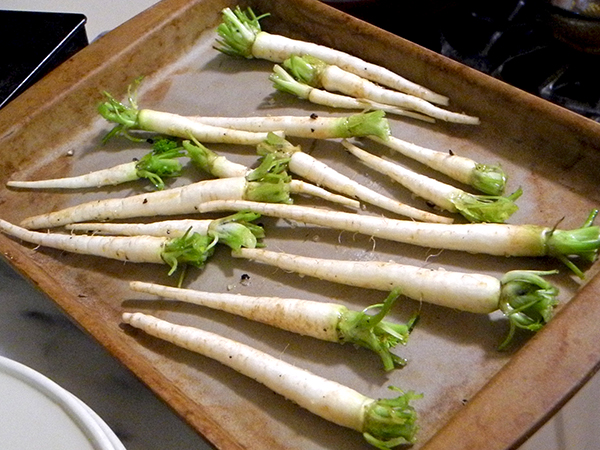
white carrots in the just-beginning-to-be-seasoned medium-sized ceramic pan

